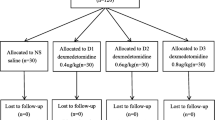Abstract
Introduction
This study was conducted to compare the effect of dexmedetomidine and labetalol on hemodynamic variables in patients undergoing microlaryngoscopy.
Material and methods
In this randomized clinical trial study 70 patients undergoing microlaryngoscopy were involved. The patients were randomly assigned into two groups. Patients in dexmedetomidine group received 0.5 μg/kg of dexmedetomidine diluted in 100 ml of saline solution and the patients in the second group received 0.25 mg/kg of labetalol before anesthesia induction. At the beginning of the surgery, dexmedetomidine was infused at the dose of 0.4 μg/kg/h in the dexmedetomidine group, and labetalol at the dose of 1.8 mg/kg/h in the labetalol group. Patients’ systolic blood pressure, diastolic blood pressure, mean arterial blood pressure and heart rate at different times and anesthesia and surgery duration, recovery time and dose of prescribed propofol were recorded and compared between two groups.
Results
There was a significant difference in mean systolic blood pressure, mean diastolic blood pressure, mean arterial blood pressure and mean heart rate between two groups at different times (p value < 0.05).
Conclusion
The results of this study indicated that dexmedetomidine had higher efficacy, compared to labetalol, in reducing diastolic blood pressure, systolic blood pressure, heart rate, and mean arterial blood pressure following microlaryngoscopy.
Similar content being viewed by others
References
Eriksson LI (2009) Miller’s anesthesia, vol 1. Elsevier Health Science, Amsterdam
Savola JM, Ruskoaho H, Puurunen J, Salonen J, Kärki N (1986) Evidence for medetomidine as a selective and potent agonist α2-adrenoreceptors. J Auton Pharmacol 6(4):275–284
Gurbet A, Basagan-Mogol E, Turker G, Ugun F, Kaya FN, Ozcan B (2006) Intraoperative infusion of dexmedetomidine reduces perioperative analgesic requirements. Can J Anesthesia. 53(7):646
Ebert TJ, Hall JE, Barney JA, Uhrich TD, Colinco MD (2009) The effects of increasing plasma concentrations of dexmedetomidine in humans. Anesthesiol J Am Soc Anesthesiol 93(2):382–394
Hall JE, Uhrich TD, Barney JA, Arain SR, Ebert TJ (2000) Sedative, amnestic, and analgesic properties of small-dose dexmedetomidine infusions. Anesth Analg 90(3):699–705
Blaudszun G, Lysakowski C, Elia N, Tramèr MR (2012) Effect of perioperative systemic α2 agonists on postoperative morphine consumption and pain intensitysystematic review and meta-analysis of randomized controlled trials. Anesthesiol J Am Soc Anesthesiol 116(6):1312–1322
Bekker A, Haile M, Kline R, Didehvar S, Babu R, Martiniuk F et al (2013) The effect of intraoperative infusion of dexmedetomidine on quality of recovery after major spinal surgery. J Neurosurg Anesthesiol 25(1):16
Zygun DA, Steiner LA, Johnston AJ, Hutchinson PJ, Al-Rawi PG, Chatfield D et al (2004) Hyperglycemia and brain tissue pH after traumatic brain injury. Neurosurgery 55(4):877–882
Dietrich WD, Alonso O, Busto R (1993) Moderate hyperglycemia worsens acute blood-brain barrier injury after forebrain ischemia in rats. Stroke 24(1):111–116
Van den Berghe G, Wilmer A, Hermans G, Meersseman W, Wouters PJ, Milants I et al (2006) Intensive insulin therapy in the medical ICU. N Engl J Med 354(5):449–461
Jabalameli M, Naghibi K, Sheibani S (2010) Comparison of plasma glucose level among traumatic patients in casualty and emergency department. J Qazvin Univ Med Sci 14(2):42–46
Laird AM, Miller PR, Kilgo PD, Meredith JW, Chang MC (2004) Relationship of early hyperglycemia to mortality in trauma patients. J Trauma Acute Care Surg 56(5):1058–1062
Desai D, March R, Watters J (1989) Hyperglycemia after trauma increases with age. J Trauma 29(6):719–723
Singh SP, Quadir A, Malhotra P (2010) Comparison of esmolol and labetalol, in low doses, for attenuation of sympathomimetic response to laryngoscopy and intubation. Saudi J Anaesthesia 4(3):163
Tanskanen P, Kyttä J, Randell T, Aantaa R (2006) Dexmedetomidine as an anaesthetic adjuvant in patients undergoing intracranial tumour surgery: a double-blind, randomized and placebo-controlled study. Br J Anaesthesia 97(5):658–665
Kumari K, Gombar S, Kapoor D, Sandhu HS (2015) Clinical study to evaluate the role of preoperative dexmedetomidine in attenuation of hemodynamic response to direct laryngoscopy and tracheal intubation. Acta Anaesthesiol Taiwan 53(4):123–130
Zhan-Ying G, Chang-Ming W, Shuai T, Lin-Lin T, Yu-Feng H (2015) Comparison of effects of different doses dexmedetomidine on inhibiting tracheal intubation-evoked haemodynamic response in the elderly patients. J Clin Diagnostic Res 9(9):UC10
Patel CR, Engineer SR, Shah BJ, Madhu S (2012) Effect of intravenous infusion of dexmedetomidine on perioperative haemodynamic changes and postoperative recovery: a study with entropy analysis. Indian J Anaesthesia 56(6):542
Talke P, Chen R, Thomas B, Aggarwall A, Gottlieb A, Thorborg P et al (2000) The hemodynamic and adrenergic effects of perioperative dexmedetomidine infusion after vascular surgery. Anesth Analg 90(4):834–839
Lee JH, Kim H, Kim H-T, Kim M-H, Cho K, Lim SH et al (2012) Comparison of dexmedetomidine and remifentanil for attenuation of hemodynamic responses to laryngoscopy and tracheal intubation. Korean J Anesthesiol 63(2):124
Yallapragada SV, Vidadala KS, Vemuri NN, Shaik MS (2014) Comparison of the efficacy of dexmedetomidine with that of esmolol in attenuating laryngoscopic and intubation response after rapid sequence induction. Anesthesia Essays Res 8(3):383
Sarkar A, Tripathi R, Choubey S, Singh RB, Awasthi S (2014) Comparison of effects of intravenous clonidine and dexmedetomidine for blunting pressor response during laryngoscopy and tracheal intubation: A randomized control study. Anesthesia Essays Res 8(3):361
Honarmand A, Safavi M, K M. The effect of labetalol or remifentanil on blood pressure and heart rate after laryngoscopy and intubation. J Isfahan Med School 1400;408(34):2017.
Author information
Authors and Affiliations
Corresponding author
Ethics declarations
Conflict of interest
Authors have no conflicts of interest.
Ethical approval
Study protocol was in accordance with the latest Declaration of Helsinki for medical research involving human subjects and was approved by ethics committee of Shahid Sadoughi University of Medical Sciences.
Research involving animals
This article does not contain any studies with animals performed by any of the authors.
Informed consent
Informed consent was obtained from all participants of the study.
Additional information
Publisher's Note
Springer Nature remains neutral with regard to jurisdictional claims in published maps and institutional affiliations
Rights and permissions
About this article
Cite this article
Hatami, M., Mashayekhi, M., Abbasi, H. et al. Comparing the effect of dexmedetomidine and labetalol on hemodynamic variables in patients undergoing microlaryngoscopy. Eur Arch Otorhinolaryngol 276, 2513–2517 (2019). https://doi.org/10.1007/s00405-019-05521-6
Received:
Accepted:
Published:
Issue Date:
DOI: https://doi.org/10.1007/s00405-019-05521-6




